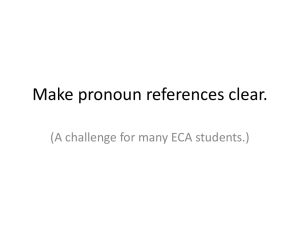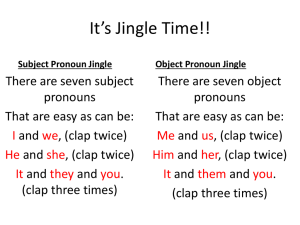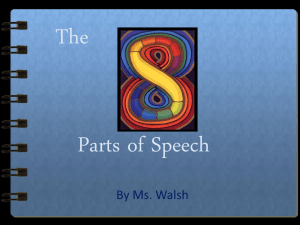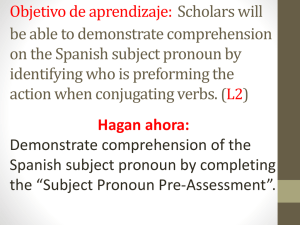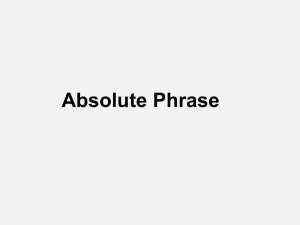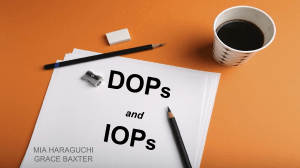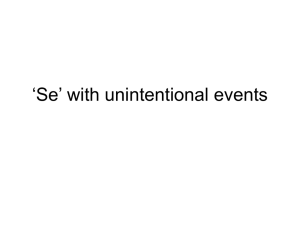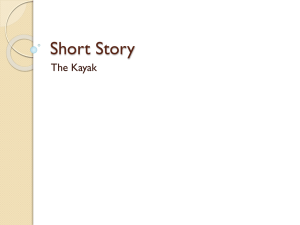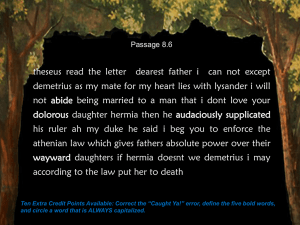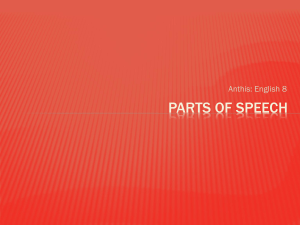powerpoint for final
advertisement
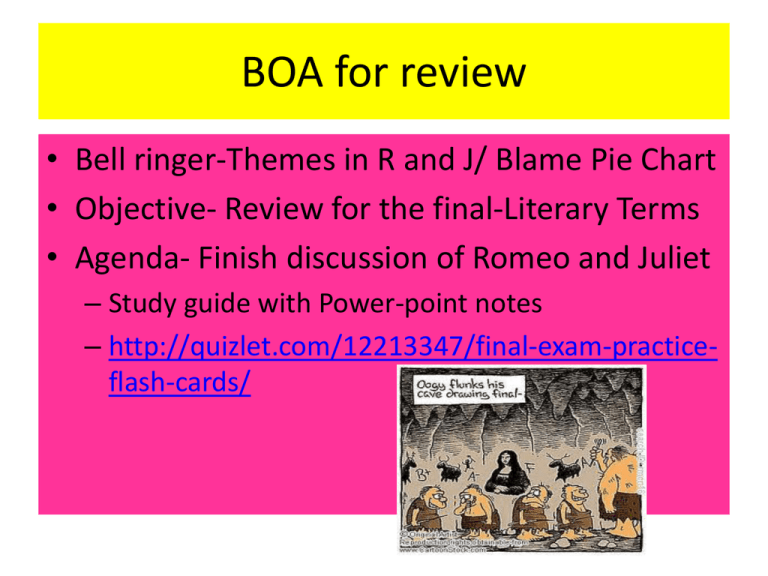
BOA for review • Bell ringer-Themes in R and J/ Blame Pie Chart • Objective- Review for the final-Literary Terms • Agenda- Finish discussion of Romeo and Juliet – Study guide with Power-point notes – http://quizlet.com/12213347/final-exam-practiceflash-cards/ th 9 Grade English Final Exam REVIEW Open-Ended Essay for the final • State a theme from ONE of the works listed below. Use TWO details from the text to support your response. • • • • Romeo and Juliet The Odyssey “The Gift of the Magi” “The Scarlet Ibis” – Theme-Central idea of a work of literature. Anecdote • An anecdote: a very brief account of an incident, especially of an interesting or amusing nature. – Napoleon was involved in conversation with a colonel of a Hungarian battalion who had been taken prisoner in Italy. The colonel mentioned he had fought in the army of Maria Theresa. "You must have a few years under your belt!" exclaimed Napoleon. "I'm sure I've lived sixty or seventy years," replied the colonel. "You mean to say," Napoleon continued, "you have not kept track of the years you have lived?" – The colonel promptly replied, "Sir, I always count my money, my shirts, and my horses - but as for my years, I know nobody who wants to steal them, and I shall surely never lose them." Author’s Purpose • People write for several different reasons, and it’s important for readers to understand the author’s purpose for writing what they are reading. • Most writing is intended to inform, to persuade, or to entertain. Bias • a particular tendency or inclination, especially one that prevents unprejudiced consideration of a question; prejudice. Characterization • The process of revealing the personality of a character in a story! How does a writer build a character out of words, someone who will seem to become flesh and bones and rise off the page, a fully realized Ebenezer Scrooge. Modern writers do not tell us much directly about their characters. They most often use the first five methods listed here: Methods of INDIRECT characterization: SPEECH APPEARANCE PRIVATE THOUGHTS OTHER CHARACTERS’ FEELINGS ACTIONS • The writer directly states what kind of person the character is: sneaky, honest, evil, innocent, kind, and so on. – “The other buddy died in the 1880’s, when she was still a child. She is still a child.” Conflict • Struggle or clash between opposing characters or opposing forces. – Internal conflict: takes place entirely within a character’s own mind – External conflict: Character struggles against an outside force (another character, society, nature, etc.) Context clues • The words and sentences surrounding a word. – Can sometimes help you guess at the meaning of an unfamiliar word. – Definition: Mathilde brought no dowry to her marriage-no property or money to give her marriage a good start. – Example: She wanted tapestries on her walls, like those beautiful embroidered hangings that decorated her friend’s home. – Contrast: M. Loisel was distracted, but Mathilde was fully involved in the party. Plot diagram Figurative Language: • Most figurative language involves some sort of imaginative comparison between seemingly unlike things. hyperbole • Figure of speech that uses exaggeration to express strong emotion or to create a comic effect. – If you say that a limousine is as long as an ocean liner, you are using hyperbole. Imagery • Language that appeals to the senses. – “Then a mile of warm sea-scented beach; – Three fields to cross till a farm appears; – A tap at the pane, the quick sharp scratch – And blue spurt of a lighted match…” » From “Meeting at Night” by Robert Browning metaphor • Figure of speech that makes a comparison between two unlike things, in which one thing becomes another thing without the use of the word like, as, than, or resembles. onomatopoeia • Use of a word whose sound imitates or suggests its meaning. (Important element in the music of poetry!) • Crackle, pop, fizz, click, and zoom are examples! personification • Kind of metaphor in which a nonhuman thing or quality is talked about as if it were human. – “This poetry gets bored of being alone, – It wants to go outdoors to chew on the winds, – To fill its commas with the keels of rowboats…” • From “Living Poetry” by Hugo Margenat simile • Figure of speech that makes a comparison between two unlike things, using a word such as like, as, resembles, or than. • Forrest Gump: My momma always said, "Life was like a box of chocolates. You never know what you're gonna get." Flashback: • Scene in a movie, play, short story, novel, or narrative poem that interrupts the present action of the plot to flash backward and tell what happened at an earlier time. • Much of the Odyssey is told in the form of flashback, as Odysseus describes his previous adventures to the Phaeacian court of King Alcinous. foreshadowing • The use of clues to hint at events that will occur later in a plot. – Used to build suspense and, sometimes, anxiety in the reader or viewer. – In “The Cask of Amontillado” when Montresor produces a trowel from beneath his cloak, Poe is foreshadowing the means Montresor will use to murder his enemy. When later he begins to build a wall around Fortunato, we remember the trowel. Genre: • The category in which a work of literature is classified. – Five major genres in literature are: • • • • • Nonfiction Fiction Poetry Drama Myth Genres • Autobiography-a history of a person's life written or told by that person. • Biography-a written account of another person's life • Drama-a composition in prose or verse presenting in dialogue especially one intended to be acted on the stage; a play. • Epic poetry-poetry celebrating the deeds of some hero • Fiction-work of literature that is invented, or imagined; a made-up story • Non-fiction-literature dealing with or offering opinions or facts and reality, including biography, history, and the essay • Sonnet- poem of 14-lines Irony-contrast between expectation and reality! • Dramatic: audience/reader knows something that a character in a play/story does not. – We know Juliet is alive, Romeo does not! • Verbal: writer/speaker says one thing, but really means something different. – Montresor says, “Your health is precious.” • Situational: contradiction between what we expect to happen and what really does take place. “The Necklace” Loaded words • Loaded words are words (or phrases) which have strong emotional overtones or connotations and which evoke strongly positive (or negative) reactions beyond their literal meaning. Unloaded Plant Animal Loaded Weed Beast Main idea • The writer’s most important point, opinion, or message. – The main idea may be stated directly, or it may be only suggested or implied. If the idea is not stated directly, it’s up to you to look at the details and decide on the idea that they all seem to support. mood • A story’s atmosphere or the feeling it evokes. – Mood is often created by a story’s setting. – “Some wounded thing, by the evidence a large animal, had thrashed about in the underbrush.” Point of View • Vantage point from which a writer tells a story. – Omniscient “all-knowing”POV- the person telling the story knows everything, but is not in the story at all. It is like a god telling the story. – First-person POV-one of the characters is telling the story, using the pronoun ‘I’. – Third-person-limited POV- the narrator, who plays NO part in the story, zooms in on the thoughts and feelings of just one character. Prefixes: • Anti-a prefix meaning “against,” “opposite of,” example: antifreeze • Bi-a prefix meaning “twice,” “two,” used in the formation of compound words: bicycle, bifocal • Co-together; joint or jointly; mutual or mutually: coproduction • Pre-before in time, rank, order, position, etc: predate; preschool • Sub-1. situated under or beneath: subterranean 2. secondary in rank; subordinate: subeditor 3. falling short of; less than or imperfectly: subarctic • Uni- prefix consisting of, relating to, or having only one: unilateral setting • The time and place of a story or play. Soliloquy • Long speech in which a character who is onstage alone expresses his or her thoughts aloud. – Friar Laurence’s-opening of Act II, Scene 3 – Juliet’s at the end of Act IV, Scene 3 – Romeo’s in Act V, Scene 3 Summary • a comprehensive and usually brief abstract of previously stated facts or statements theme • Central idea of a work of literature. – Not the same as a subject. The subject can be expressed in a word or two: love, childhood, death. • Theme is the idea the writer wishes to reveal about that subject. The theme is something that can be expressed in a least one complete sentence. – “Love is more powerful than hatred.” Tone • Attitude a writer takes toward a subject, a character, or the audience. – Tone is conveyed through the writer’s choice of words and details. Types of Essays or Texts • Informative-communicate information and data • Narrative-a story or account of events, experiences whether true or fictitious. • Persuasive- intended to persuade Writing Formats • Cause/effect-a text structure that shows how or why one thing leads to another. • Compare/contrast-a method of organizing information by showing similarities and differences among various groups of details. • Question/answer • Sequence- the following of one thing after another; succession- a list of books in alphabetical sequence; a continuous or connected series: a sonnet sequence. BOA for Today! • Bell ringer: How to get to Quizzlet! • Objective: Review for the grammar part of the final • Agenda: Quizzlet – – – – – – – Pass back Writing Folder/Discuss Prompt again! Pass back Reading Folder/4-Sight results (bonus) Think-Tac-Toe Bonus (collected?) Book Talks Study guide Collect Hall passes and Metzger $ Post Answers Appositives • An appositive is a noun or a pronoun placed beside another noun or pronoun to identify or describe it. – Punctuate with commas! Commas are generally used with appositives that refer to proper nouns. “His father, Richie, comes back to town.” – Erik Myers Nonessential appositives should be set off with commas. (Info. not necessary to the meaning of the sentence.) Their new parrot, Mina, is very gentle. Essential appositives add information that makes the noun or pronoun it identifies more specific. He recited the second stanza of “The Raven” by the poet Edgar Allan Poe. (no commas needed because it identifies which poet.) Capitalization • Capitalize geographical names. – the Grand Canyon Gulf of Mexico Europe – Capitalize the first and last words and all important words in titles and subtitles. • The New York Times Saturday Night Live – Capitalize a person’s title, a word showing a family relationship when the word is used in place of a name. • Aunt Flora my uncle Bert Ms. Ana Sanchez Sentence Fragments • A sentence is a word group that contains a subject and a verb and that expresses a complete thought. – Fragment: Bears extremely protective of their young. (no verb) – Fragment: According to the film we saw. (incomplete thought) – Sentence: According to the film we saw, bears are extremely protective of their young. Run-on sentence • Two or more complete sentences run together as one. (Confuses the reader!) – Fused sentence- no punctuation at all between the two sentences. • Schools in the Middle Ages were different from ours students usually did not have books. • Comma splice-writer links together sentences with only a comma to separate them from one another. – Schools today have books for every student, many schools also have laptops and online texts. Examples of how to fix a run-on: “Malgus and Aryn battle, but he spares her.” Use a comma before FANBOYS! OR “Malgus’ wife dies. He goes into a frenzy.” Make it into two separate sentences! –Adam Hoffman Dashes • Use a dash to indicate an abrupt break in thought or speech or an unfinished statement or question. – I simply cannot understand-Sean, are you listening to me?-why anyone would not turn in a project. – “How can I help you when I don’t know-”the teacher broke off when she saw the anguish on the student’s face. – Use a dash to indicate namely, that is, or in other words or to introduce an explanation. • Shelby is perfect for the part-her fiery personality makes her perfect for the role of Tybalt. Colons : • Use a colon to mean “note what follows” – Use before a list of items • Please submit copies of the following documents: your driver’s license, birth certificate, and Social Security card. -Use a colon before a long, formal statement or a long quotation. This is how I plan to begin my oral report on poetry: “If you want to express a complicated thought with the fewest but most memorable words, consider learning how to write a poem.” -Use a colon between independent clauses when the second clause explains or restates the idea of the first. Your poem is a complete success: It is original, and its rhythms mimic the sounds of waves! Using “I” versus “Me” The two personal pronouns I and me are often used wrongly, usually in sentences in which I is being used with another noun. Here are some tips to help you get it right: • •Use the pronoun I, along with other subjective pronouns such as we, he, she, you, and they, when the pronoun is the subject of a verb: He went to bed. We waited for the bus. Clare and I are going for a coffee. In the last example, the pronoun I, together with the proper noun Clare, forms the subject of the sentence, so you need to use I rather than me. • •Use the pronoun me, along with other objective pronouns such as us, him, her, you, and them, when the pronoun is the object of a verb: Danny thanked them. The dog followed John and me to the door. In the last example, the pronoun me, together with the proper noun John, forms the object of the verb follow, so you need to use me rather than I. • •Use the pronoun me, along with other objective pronouns such as us, him, her, you, and them, when the pronoun is the object of a preposition: Rose spent the day with Jake and me. Me, together with Jake, forms the object of the preposition with, so you need to use the pronoun me rather than the pronoun I. • An easy way of making sure you’ve chosen the right pronoun is to see whether the sentence reads properly if you remove the additional noun: » CORRECT INCORRECT √ I am going for a coffee √ The dog followed me √ Rose spent the day with me X Me am going for a coffee X The dog followed I X Rose spent the day with I Open-Ended Essay for the final • State a theme from ONE of the works listed below. Use TWO details from the text to support your response. • • • • Romeo and Juliet The Odyssey “The Gift of the Magi” “The Scarlet Ibis” – Theme-Central idea of a work of literature.

